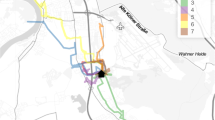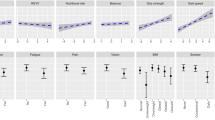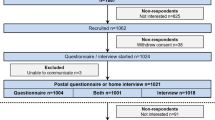Abstract
Mobility in older adults is associated with better quality of life. However, evidence suggests that older people spend less time out-of-home than younger adults. Traditional methods for assessing mobility have serious limitations. Wearable technologies provide the possibility of objectively assessing mobility over extended periods enabling better estimates of levels of mobility to be made and possible predictors to be explored. Eighty-six community dwelling older adults (mean age 79.8 years) had their mobility assessed for one week using GPS, accelerometry and self-report. Outcomes were: number of steps, time spent in dynamic outdoor activity, total distance travelled and total number of journeys made over the week. Assessments were also made of personal, cognitive, psychological, physical and social variables. Four regression models were calculated (one for each outcome). The models predicted 32 to 43% of the variance in levels of mobility. The ability to balance on one leg significantly predicted all four outcomes. In addition, cognitive ability predicted number of journeys made per week and time spent engaged in dynamic outdoor activity, and age significantly predicted total distance travelled. Overall estimates of mobility indicated step counts that were similar to those shown by previous research but distances travelled, measured by GPS, were lower. These findings suggest that mobility in this sample of older adults is predicted by the ability to balance on one leg. Possible interventions to improve out-of-home mobility could target balance. The fact that participants travelled shorter distances than those reported in previous studies is interesting since this high-functioning subgroup would be expected to demonstrate the highest levels.
Similar content being viewed by others
References
Office of National Statistics. Focus on Older People, 2005.
Mollenkopf H, Baas S, Marcellini F, et al. A new concept of out-of-home mobility. Enhancing mobility in later life. Personal coping, environmental resources and technical support. The out-of-home mobility of older adults in urban and rural regions of five European countries 2005: 257–277.
Mollenkopf H, Marcellini F, Ruoppila I, et al. Social and behavioural science perspectives on out-of-home mobility in later life: findings from the European project MOBILATE. Eur J Ageing 2004; 1(1): 45–53.
Guralnik JM, LaCroix AZ, Abbott RD, et al. Maintaining Mobility in Late Life. Demographic Characteristics and Chronic Conditions. Am J Epid 1993; 137(8): 845–857.
Davis MG, Fox KR, Hillsdon M, et al. Objectively measured physical activity in a diverse sample of older urban UK adults. Med Sci Sports Exerc 2011; 43(4):647–54.
Fobker S, Grotz R. Everyday mobility of elderly people in different urban settings: The example of the city of Bonn, Germany. Urban Studies 2006; 43(1): 99–118.
May D, Nayak USL, Isaacs B. The life-space diary: A measure of mobility in old people at home. Disabil Rehabil 1985; 7(4): 182–186.
Paez A, Scott D, Potoglou D, et al. Elderly Mobility: Demographic and Spatial Analysis of Trip Making in the Hamilton CMA, Canada. Urban Studies 2007; 44(1): 123–146.
Rabbitt P, Maylor E, McInnes L, et al. What goods can self-assessment questionnaires deliver for cognitive gerontology? App Cog Psy 1995; 9(7): S127–S152.
Hagströmer M, Oja P, Sjöström M. Physical Activity and Inactivity in an Adult Population Assessed by Accelerometry. Med Sci Sports Exerc 2007; 39(9): 1502–1508
Lord S, Chastin SFM, McInnes L, et al. Exploring patterns of daily physical and sedentary behaviour in community-dwelling older adults. Age Ageing 2011; 40(2): 205–210.
Chan CS, Slaughter SE, Jones CA, Wagg, AS. Measuring activity performance of continuing care residents using the Activpal: An exploratory study. J Frailty Aging 2016; 5(3): 158–161.
Bogen B, Aaslund, MK, Ranhoff, AH, Taraldsen K, Moe-Nilssen R. J. The association between daily walking behaviour and self-reported physical function in community dwelling older adults. J Frailty Aging 2017; 6(2): 88–90
Garmin L. 1996–2012; Available from: http://www8.garmin.com/aboutGPS/.
Kerr J, Marshall S, Godbole S. et al. The relationship between outdoor activity and health in older adults using GPS. Int. J. Environ. Res. Public Health 2012; 9: 4615–4625.
Shoval N, Auslander G, Freytag T, et al. The use of advanced tracking technologies for the analysis of mobility in Alzheimer’s disease and related cognitive diseases. BMC Geriatrics 2008; 8(1): 7.
Hirsch JA, Winters M, Clarke P, McKay, H. Generating GPS activity spaces that shed light upon the mobility habits of older adults: a descriptive analysis. Int J Health Geogr 2014; 13:51.
Webber SC, Porter MM. Monitoring mobility in older adults using global positioning system (GPS) watches and accelerometers: a feasibility study. J Aging Phys Act 2009; 17(4): 455–467.
Cornwell EY, Cagney KA. Aging in activity space: results from smartphone-based GPS-tracking of urban seniors. J Gerontol B Psychol Sci Soc Sci, 2017; 72(5): 864–875.
Yen IH, Leung CW, Lan M, et al. 20 A Pilot Study Using Global Positioning Systems (GPS) Devices and Surveys to Ascertain Older Adults’ Travel Patterns. J Appl Gerontol, 2015; 34(3): NP190–NP201.
Shoval N, Auslander G, Cohen-Shalom K, et al. What can we learn about the mobility of the elderly in the GPS era? J Trans Geog 2010; 18(5): 603–612.
Lord SE, Weatherall M, Rochester L. Community Ambulation in Older Adults: Which Internal Characteristics Are Important? Arch Phys Med Rehabil 2010; 91(3): 378–383.
Scheffer AC, Schuurmans MJ, van Dijk N, et al. Fear of falling: measurement strategy, prevalence, risk factors and consequences among older persons. Age Ageing 2008; 37(1): 19–24.
Rabbitt PMA, McInnes L, Diggle P, et al. The University of Manchester Longitudinal Study of Cognition in Normal Healthy Old Age, 1983 through 2003. Aging, Neuropsychol Cog 2004; 11(2): 245–279.
Springer BA, Marin R, Cyhan T, Roberts H, Gill NW. Normative values for the unipedal stance test with eyes open and closed. J Geriatr Phys Ther 2007; 30(1):8–15.
Grant P, Dall P, Mitchell S, et al. Activity-monitor accuracy in measuring step number and cadence in community-dwelling older adults. J Aging Phys Act 2008; 16(2): 201–214.
Chastin SFM, Granat MH. Methods for objective measure, quantification and analysis of sedentary behaviour and inactivity. Gait Posture 2010; 31: 82–86.
Hughes SL, Seymour RB, Campbell RT, et al. Best-Practice Physical Activity Programs for Older Adults: Findings from the National Impact Study. Am J Public Health 2009; 99(2): 362–368.
Muir SW, Berg K, Chesworth B, et al. Balance Impairment as a Risk Factor for Falls in Community-Dwelling Older Adults Who Are High Functioning: A Prospective Study. Phys Ther 2010; 90(3): 338–347.
Madureira MM, Bonfá E, Takayama L, et al. A 12-month randomized controlled trial of balance training in elderly women with osteoporosis: Improvement of quality of life. Maturitas 2010; 66(2): 206–211.
Shoval N, Wahl H-W, Auslander G, et al. Use of the global positioning system to measure the out-of-home mobility of older adults with differing cognitive functioning. Ageing Soc 2011; 31(05): 849–869.
Ayabe M, Yahiro T, TYoshioka M, et al. Objectively measured age-related change in the intensity distribution of daily physical activity in adults. J Phys Act Health 2009; 6(4): 419–425.
Anderson M, Perrin A. Tech Adoption Climbs Among Older Adults. Pew Research Center, 2017; May
Howe TE, Rochester L, Jackson A, et al. Exercise for improving balance in older people (Review). Cochrane Database of Systematic Reviews 2008; (4).
Funding
Funding: This work was supported by the New Dynamics of Ageing initiative, a multidisciplinary research programme supported by AHRC, BBSRC, EPSRC, ESRC and MRC: Grant number RES - 352 -25 - 0023. We acknowledge the support of the UK NIHR Biomedical Research Centre for Ageing and Age-related disease award to the Newcastle upon Tyne Hospitals NHS Foundation Trust.
Author information
Authors and Affiliations
Corresponding author
Ethics declarations
Ethical standards: This study was approved by the School of Life Sciences Ethics Committee, Northumbria University.
Additional information
Conflict of Interest: The authors have nothing to disclose.
Rights and permissions
About this article
Cite this article
McInnes, L., Jones, E., Rochester, L. et al. Mobility in Community Dwelling Older Adults: Predicting Successful Mobility Using an Instrumented Battery of Novel Measures. J Frailty Aging 9, 68–73 (2020). https://doi.org/10.14283/jfa.2019.35
Received:
Accepted:
Published:
Issue Date:
DOI: https://doi.org/10.14283/jfa.2019.35




